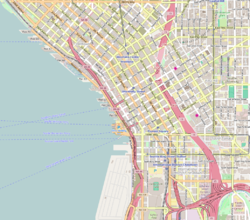Interurban Building | |
 The building's exterior, 2007 | |
| Location | 102 Occidental Way S Seattle, Washington |
|---|---|
| Coordinates | 47°36′5.24″N 122°19′56.95″W / 47.6014556°N 122.3324861°W |
| Built | 1890–1891 |
| Built by | Matthew Dow |
| Architect | John B. Parkinson |
| Architectural style | Romanesque Revival Richardsonian Romanesque |
| Part of | Pioneer Square Historic District (ID70000086) |
| Designated CP | June 22, 1970 |
The Interurban Building, formerly known as the Seattle National Bank Building (1890–1899), the Pacific Block (1899–1930) and the Smith Tower Annex (1930–1977), is a historic office building located at Yesler Way and Occidental Way S in the Pioneer Square neighborhood of Seattle, Washington, United States. Built from 1890 to 1891 for the then recently formed Seattle National Bank, it is one of the finest examples of Richardsonian Romanesque architecture in the Pacific Northwest and has been cited by local architects as one of the most beautiful buildings in downtown Seattle.[1] It was the breakthrough project of young architect John Parkinson, who would go on to design many notable buildings in the Los Angeles area in the late 19th and early 20th century.[2]
The Seattle National Bank would vacate the building after only five years, followed by numerous legal battles between its owners, creditors and builders that ultimately led to the foreclosure of the building. It came under the ownership of New York industrialist Lyman Cornelius Smith who would rename it the Pacific Block in 1899. From 1904 to 1928, the Puget Sound Electric Railway's Seattle–Tacoma interurban line terminated in front of the building and the former bank lobby was used as a ticket office and waiting room. The building was threatened with demolition several times in the 1910s and 1920s but plans to replace the building with a skyscraper always fell, though. The building underwent a major interior modernization beginning in 1929 under L.C. Smith's heirs, which included demolition of the entire Southeast wing of the building. The building was renamed again to the Smith Tower Annex, which it would remain until its most recent restoration in the late 1970s after which it was renamed the Interurban Building as a nod to its role in local transportation. It was listed on the National Register of Historic Places in 1970 as a contributing property to the Pioneer Square Historic District.
- ^ Dunham, Sandy Deneau (September 7, 2017). "Beauty beholders - We asked local architects and interior designers — along with readers, via Facebook — to share their votes for downtown Seattle's most beautiful building". The Seattle Times. Retrieved April 6, 2021.
- ^ "Summary for 102 Occidental Way". Seattle Historical Sites. Seattle Department of Neighborhoods. Retrieved April 6, 2021.

